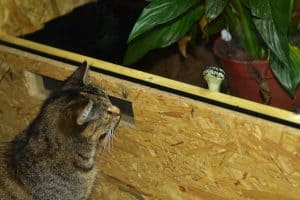Cats are known for their sharp claws, which serve various purposes in their daily lives. But have you ever wondered why cats’ claws are so sharp? Let’s explore the reasons behind this unique feline feature.
Evolution of Sharp Claws
Cats didn’t just wake up one day with razor-sharp claws; they had to earn those bad boys through generations of evolution. Back in the day, cats’ ancestors needed those sharp claws to survive in the wild. Imagine trying to hunt down a meal without the proper tools – it just wouldn’t be pretty. So, over time, cats evolved to have these sharp claws as a crucial adaptation for hunting and defending themselves.
Role in Hunting
When your feline friend goes into full-on hunting mode, those sharp claws become their ultimate weapon. Picture this: a stealthy predator lurking in the shadows, waiting for the perfect moment to strike. With a swift swipe of their claws, cats can capture prey or defend themselves against potential threats in the blink of an eye. These claws aren’t just for show – they serve a practical purpose in the wild, helping cats secure their next meal and stay safe in the face of danger.
But here’s the kicker – those claws aren’t just for hunting. Cats also use them for climbing, marking territory, and even stretching out those kitty muscles. It’s like having a multi-tool attached to their paws at all times. So, the next time you see your cat sharpening those claws on your favorite furniture, remember they’re just following their natural instincts.
Marking Territory
Cats are natural-born communicators, and sharp claws play a pivotal role in their social interactions. By leaving scratch marks on various surfaces, cats are essentially marking their territory. This is their way of sending messages to other feline friends, conveying information about their presence and boundaries. So, when your cat scratches the arm of your favorite couch, it’s not being mischievous—it’s just saying, “Hey, this is mine!”
Maintenance and Health
Now, let’s talk about why those sharp claws are crucial for your feline friend’s overall well-being. Apart from being essential for self-defense, claws are also vital for grooming. Cats use them to clean themselves, removing dirt, debris, and loose fur. Additionally, claws help cats stretch their muscles and tendons, promoting healthy joints and preventing stiffness. So, next time you see your furry companion sharpening its claws on a scratching post, know that it’s not just a playful act—it’s a way for them to maintain their health and stay agile.
Additional Insight:
Here’s a pro tip: to keep your cat mentally stimulated and physically active, provide them with different types of scratching surfaces, such as cardboard, sisal, or carpet. This variety will not only keep their claws healthy but also prevent them from getting bored and resorting to scratching forbidden items.
Different Types of Claws
Cats have impressive sharp claws that serve various functions in their daily lives. These claws come in different types, each tailored for specific purposes. The front claws, also known as retractable claws, help cats grip and hold onto objects, climb trees, and defend themselves when necessary. On the other hand, the rear claws aid in providing balance and stability while running or jumping.
Moreover, cats’ claws are designed with a hook-like shape that helps them catch and grab prey efficiently. This unique shape allows cats to grasp onto their food and bring it closer for consumption. Additionally, the sharpness of their claws allows cats to climb vertical surfaces effortlessly, giving them the advantage of height when necessary.
Trivia: Cat Claw Facts
Curious about some intriguing cat claw facts? Here’s a fascinating tidbit: did you know that cats can retract and extend their claws at an amazing speed of 150 milliseconds? This rapid movement enables them to switch between using their claws for various activities quickly.
Another interesting fact is that cats’ claws are always sharp due to their unique composition. Unlike human nails that grow continuously, cats’ claws shed regularly to maintain sharpness. This shedding process allows cats to have a constant supply of sharp claws for hunting, climbing, and defending themselves.
Additional Insight: Cats’ claws are not just essential tools for survival but also play a crucial role in their overall well-being. Regular claw maintenance, such as scratching objects, helps cats remove the dead outer layer of their claws, promoting healthy growth and preventing overgrowth. Encouraging this natural behavior in domestic cats can help prevent potential issues related to their claws.
Claw Care Tips
Keeping your cat’s claws healthy is essential for their overall well-being. Here are some tips to help you properly care for your feline friend’s claws:
- Regular Trimming: Trim your cat’s claws every 2-4 weeks to prevent them from becoming overgrown. Use specialized cat nail clippers and be careful not to trim too close to the quick.
- Scratching Posts: Provide your cat with scratching posts to help them naturally file down their claws. Encourage their use by sprinkling catnip on the posts or using a scratching post made of materials that cats love to scratch, like sisal or cardboard.
- Regular Veterinary Check-Ups: Schedule regular check-ups with your veterinarian to monitor the health of your cat’s claws. Your vet can also trim your cat’s claws if you’re not comfortable doing it yourself.
Remember, a cat’s claws are a crucial part of their anatomy and play a significant role in their daily life. By following these tips, you can ensure that your cat’s claws remain sharp and healthy without resorting to harmful methods like declawing.
Alternatives to Declawing
Declawing, also known as onychectomy, is a painful and unnecessary procedure that should be avoided. Here are some alternatives to declawing that can help you manage your cat’s claws effectively:
- Regular Trimming: As mentioned earlier, regular claw trimming is an effective way to keep your cat’s claws in check. If you’re unsure how to trim your cat’s claws safely, consult your veterinarian or a professional groomer.
- Soft Paws: Soft Paws are vinyl nail caps that can be applied to your cat’s claws to prevent scratching. These caps are humane and painless, providing a safe alternative to declawing.
- Behavior Modification: If your cat is scratching furniture or other inappropriate surfaces, try redirecting their behavior by providing them with alternative scratching surfaces like scratching posts or pads.
By exploring these alternatives to declawing, you can ensure that your cat’s claws remain sharp and healthy while protecting their well-being and quality of life.
Interaction with Humans
Cats use their sharp claws to communicate various messages with their human companions. When your feline friend kneads on your lap or stretches out their claws on your furniture, they are not trying to be destructive – they are simply marking their territory. This behavior signifies that they feel safe and comfortable in your presence. It’s their way of bonding with you and showing affection.
Understanding your cat’s behavior is crucial in maintaining a harmonious relationship. By recognizing the significance of their sharp claws in their communication, you can respond appropriately and provide them with the care and attention they need. So next time you see your cat sharpening their claws on your favorite chair, remember they are not trying to annoy you; they are simply expressing themselves.
Conclusion: The Significance of Sharp Claws
Sharp claws are essential for cats in their daily lives for a variety of reasons. Not only do they use their claws for scratching and marking territory, but also for climbing, hunting, and defending themselves. It is crucial to respect and care for this unique feline feature to ensure your cat’s overall well-being.
Regular nail trimming and providing appropriate scratching posts can help maintain your cat’s claws and prevent any unwanted scratching incidents. By understanding the importance of sharp claws in your cat’s life, you can create a cat-friendly environment that promotes their natural behaviors. Remember, those sharp claws are not just for show – they are an integral part of your cat’s everyday activities.
Alex, a passionate animal lover, has experience in training and understanding animal behavior. As a proud pet parent to two dogs and three cats, he founded AnimalReport.net to share insights from animal experts and expand his knowledge of the animal kingdom.









